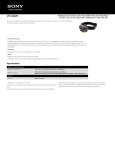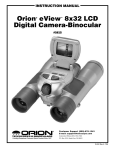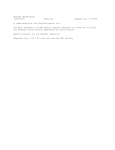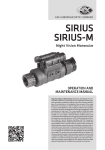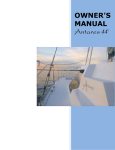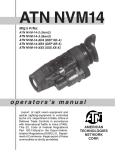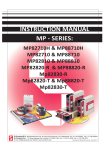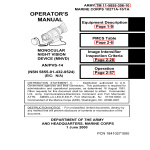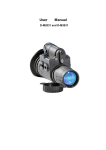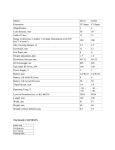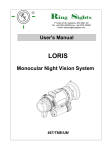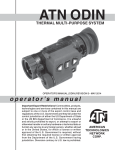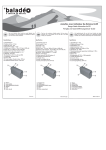Download User Manual
Transcript
NVM-MANUAL OPERATOR MANUAL FOR THE Multi-Use Minimonocular NVG (MUM2) MFG P/N: NVM-000-A1/A2 ITI-Manual Revision 2.2 – March 2005 SAFETY SUMMARY CAUTIONS 2 The MUM is a precision optical instrument and must be handled carefully at all times to prevent damage. Do not scratch the external lens surfaces or touch them with your fingers. The demist coating on the demist shield can be damaged if cleaned while wet or cleaned with wet lens paper. Clean only when the demist shield is dry and only use dry lens paper. To protect the image intensifier, keep the lens cap on the objective lens when the monocular is not in use or when operated in daylight conditions. Be careful not to touch the glass surfaces. If you get fingerprints or contamination of the glass surfaces, use lens paper to clean the sacrificial window. If moisture is needed, use your breath to mist the surface of the glass prior to wiping. The IR illuminator is a light that is invisible to the unaided eye for use during conditions of extreme darkness. However, the light from the illuminator can be detected by a night vision equipped enemy. It is recommended that the eyecup be replaced with the optional shuttered eye guard during weapon-mounted use. a NOTES 2 The MUM is not a weapon sight, however, it can be used in conjunction with a collimated dot sight or laser aiming device. When utilizing the MUM2 for driving purposes, the goggles may not be used in the hand-held mode. The goggles must be worn on the head- or helmet-mounted position. At operating temperatures below –20°C (-4°F), alkaline batteries are not recommended, as operating life will be severely reduced. Lithium-iron disulfide 1.5V AA batteries, 123A 3.0VDC Lithium, or equivalent should be used below – 20°C (-4°F). The purpose of the illuminator is for viewing at close distance up to 3 meters when additional illumination is needed. To move the power switch from the OFF position, you must push in the switch, and then turn it. Make sure that shading is not the result of improper eyerelief adjustment. b EQUIPMENT LIMITATIONS To avoid physical and equipment damage when using the 2 MUM , carefully read and understand the following safety precautions. • The equipment requires some night light (moonlight, starlight, etc.) to operate. The level of performance depends upon the level of light. • Night light is reduced by passing cloud cover, while operating under trees, in building shadows, etc. • The equipment is less effective viewing into shadows and other darkened areas. • The equipment is less effective through rain, fog, sleet, snow or smoke. The equipment will not “see” through dense smoke. • Adjust vehicular speed to prevent overdriving the range of view when conditions of possible reduction or loss of vision exist. • Long exposure to high levels of external light source for extended periods of time can significantly reduce the service life of the image intensifier tube and permanently degrade the equipment. c This page intentionally left blank. d TABLE OF CONTENTS SAFETY SUMMARY.............................................................a EQUIPMENT LIMITATIONS ................................................. c TABLE OF CONTENTS ......................................................... i LIST OF FIGURES................................................................ ii LIST OF TABLES ................................................................. iii HOW TO USE THIS MANUAL ............................................. iv SECTION I .........................................................................1-1 GENERAL INFORMATION ...........................................1-1 SECTION II ........................................................................2-1 EQUIPMENT DESCRIPTION........................................2-1 SECTION III .......................................................................3-1 MOUNTING PROCEDURES.........................................3-1 SECTION IV .......................................................................4-1 OPERATING PROCEDURES .......................................4-1 SECTION V ........................................................................5-1 OPERATIONAL DEFECTS ...........................................5-1 SECTION VI .......................................................................6-1 MAINTENANCE.............................................................6-1 APPENDIX A..................................................................... A-1 END ITEM COMPONENTS.......................................... A-1 APPENDIX B..................................................................... B-1 REPAIR PARTS LIST................................................... B-1 i LIST OF FIGURES 2 Figure 1- 1 Helmet Mounted MUM ..................................1-1 Figure 2- 1 Weight, Dimensions, and Performance .........2-2 Figure 2- 2 ..........................................................................2-3 Figure 3- 1 Attaching Weapon Mount to Weapon .............3-1 2 Figure 3- 2 Attaching MUM to Weapon Mount.................3-2 2 Figure 3- 3 Attaching MUM to Head/Helmet Mount Adapter ..................................................................................3-3 2 Figure 3- 4 Attaching MUM to Head Mount .....................3-4 Figure 4- 1 DL-123A Battery Installation ...........................4-2 Figure 4- 2 AA Battery Installation ....................................4-2 Figure 4- 3 Mechanical Functions .....................................4-3 Figure 5- 1 Figure 5- 2 Figure 5- 3 Figure 5- 4 Figure 5- 5 Shading...........................................................5-1 Edge Glow ......................................................5-2 Bright Spots and Emission Points...................5-4 Fixed Pattern Noise ........................................5-5 Chicken Wire ..................................................5-6 Figure 6- 1 Neck pad Reinstallation ................................6-16 Figure 6- 2 Lacing the Sliding Bar Buckle .......................6-17 Figure A- 1 Components of the End Item........................ A-1 Figure B- 1 Repair Parts ................................................. B-1 ii LIST OF TABLES 2 Table 2- 1 MUM Major Components................................2-4 Table 4- 1 Battery Life .......................................................4-1 Table 6- 1 ...........................................................................6-2 2 Table 6- 2 Operator Troubleshooting for MUM ..............6-12 Table A- 1 Components of the End Item.......................... A-2 Table B- 1 Repair Parts List ............................................. A-2 iii HOW TO USE THIS MANUAL Usage You must familiarize yourself with the entire manual before operating the equipment. Read the complete maintenance task before performing maintenance and follow all WARNINGS, CAUTIONS, and NOTES. Manual Overview The manual contains sections for Operating and Maintaining the Multi-Use Minimonocular NVG. Components of End Item are in Appendix A. Repair Parts List is in Appendix B. iv SECTION I GENERAL INFORMATION 2 Figure 1- 1 Helmet Mounted MUM 1-1 1.1 GENERAL INFORMATION a. Type of Manual: Operator (Including Repair Parts List). b. Model Numbers and Equipment Name: 2 2 NVM-000-A1 – MUM without I tube 2 2 NVM-000-A2 – MUM with I tube c. Manufacturer: Insight Technology, Incorporated 9 Akira Way Londonderry, NH 03053 d. Purpose of Equipment: To provide the soldier with the ability to observe at night 2 under moonlight and starlight conditions. The MUM can be handheld, head mounted, helmet mounted or weapon mounted to enable walking, driving, weapon firing, shortrange surveillance, map reading, vehicle maintenance, underwater diving, and administering first aid. The unit allows for horizontal and vertical adjustments when head or helmet mounted and is also equipped with an infrared lightemitting source. 1.2 WARRANTY INFORMATION: This item shall conform to design, manufacturing, and performance requirements and be free from defects in material and workmanship for a period of one (1) year from the date of shipment. If item is defective, notify your Service Command Technical point of contact. 1.3 TECHNICAL INFORMATION: For technical information contact Insight Technology directly at 603.626.4800, or [email protected] or your Service Command point of contact. 1-2 1.4 LIST OF ABBREVIATIONS cm....................... Centimeters BAT .................... Battery g ......................... Grams Illum.................... Illuminator in......................... Inches IR........................ Infrared m ........................ Meters mm ..................... Millimeters 2 MUM ................. Multi-Use Minimonocular NVG NVG's ................. Night Vision Goggles Oz........................ounces 1-3 This page intentionally left blank. 1-4 SECTION II EQUIPMENT DESCRIPTION 2.1 SYSTEM DESCRIPTION 2 The MUM is a hand-held, head-mounted, helmet-mounted, or weapon-mounted night vision system that enables walking, driving, weapon firing, short-range surveillance, map reading, vehicle maintenance, underwater diving, and administering first aid in both moonlight and starlight. Each unit allows for vertical adjustment (by using head straps), fore-and-aft adjustment, objective lens focus, and eyepiece focus. The device is also equipped with an infrared lightemitting source. 2-1 2.2 WEIGHT, DIMENSIONS, AND PERFORMANCE Figure 2- 1 Weight, Dimensions, and Performance WEIGHT AND DIMENSIONS Weight (with mounting 265 g hardware) Length 10.4 cm Width 4.4 cm Height 6.4 cm PERFORMANCE Magnification 1x f-Number 1.2 2 40° +/- 2° with 18 mm I Field of View tube format Focus Range 25cm (9.8in.) to infinity Eyepiece Diopter Adj. Eye Relief -6 to +4 27mm Voltage 3.0 VDC Power Requirements 1 DL123A or 1 AA Waterproof 20 meters CONTINUOUS OPERATION 1 DL123A battery >40 hours 1 AA battery >20 hours 2-2 2.3 DESCRIPTION OF MAJOR COMPONENTS 1 2 4 3 8 7 6 11 12 5 9 10 13 14 15 16 17 2 Figure 2- 2 MUM Major Components 2-3 2 ITEM Table 2- 1 MUM Major Components DESCRIPTION Kit Components Weapon Mount Assembly Neck Cord Headmount Adapter Assembly Eye Cup Shoulder Strap Lens Cap Sacrificial Window 2 MUM Assembly Demist Shield Headmount Assembly Lens Tissue AA Battery, Alkaline, 1.5v Battery Sleeve Adapter Lithium Battery DL123, 3v Browpads (Thin, Medium, Large) Operator Manual Soft Carrying Case Optional Components Camera/Camcorder Adapter Dive Window Flip-up Helmet Mount Dual Carriage Mount 3x or 5xAfocal Lens 3x Lens (Custom Order) Infrared Flood/Spot Compass Shipping/Storage Case (optional) Shuttered Eyeguard (optional) 1 2 3 4 5 6 7 8 9 10 11 12 13 14 15 16 17 2-4 2.3.1 MAJOR COMPONENTS 1. Weapon Mount Assembly 2 A small arms adapter that allows the MUM to be mounted on a weapon. 2. Neck Cord The neck cord is worn around the neck and also tethers the 2 lens cap to the MUM . 3. Headmount Adapter Assembly 2 This item attaches the MUM to the head mount or helmet mount. 4. Eye Cup A rubber cup used for operator comfort, to protect eyepiece, and for nighttime back light security. 5. Shoulder Strap Allows the carrying bag to be slung across the shoulder for ease of carrying. 6. Lens Cap A cap used to protect the lens, and for testing the unit in daylight. 7. Sacrificial Window A replaceable window supplied to protect the objective lens during operation in adverse conditions. This o-ring sealed window also doubles as the objective lens dive window. 2 8. MUM Assembly The monocular night vision device with unity magnification. 2-5 9. Demist Shield Used to prevent eyepiece lenses from becoming fogged. This o-ring sealed window also doubles as the objective lens dive window. 10. Headmount Assembly 2 Adjustable universal assembly that secures the MUM to the operator’s head providing hands free operation. 11. Lens Tissue Lens Tissue cleans the lenses during maintenance. 12. Battery, AA Alkaline, 1.5v A single, AA alkaline battery is used to power the unit. 13. Battery Sleeve Adapter 2 Allows the MUM to accept a single, standard AA alkaline battery used to power the unit, instead of the Lithium Battery. 14. Battery, DL123A Lithium, 3v A single, 123A lithium battery is used to power the unit. 15. Brow pads (Thin, Medium, or Large) Varying thickness brow pads are provided to allow the head mount assembly to adapt to differing head sizes. 16. Operator Manual Provides equipment description, use of operator controls and preventative maintenance. 17. Soft Carrying Case 2 A protective nylon bag used for storing the MUM and accessories. 2-6 2.3.2 OPTIONAL COMPONENTS (not shown) Camera/Camcorder Adapter This adapter attaches to the eyepiece for collection of 2 imagery from the MUM . Dive Window 2 This window attaches to the MUM prior to submerging to protect it during diving operations. Flip-up Helmet Mount 2 Provides mount interface for the MUM to a range of ballistic helmets. Dual Carriage Mount 2’ Adapter that allows two MUM s to be attached in a binocular configuration 3x or 5x Afocal Lens 2 Attaches to the MUM for enhanced range performance 3x Lens (Custom Order) 2 Attaches to the MUM for enhanced range performance Infrared Flood/Spot Focusing lens for the extended source IR LED to narrow or widen the illumination beam. Compass Projects magnetic azimuth orientation into the operator’s 2 field of view when using the MUM . Shipping/Storage Case 2 A hard plastic case designed to protect all MUM components during shipping/storage. 2-7 Shuttered Eyeguard Used to maintain display backlight security. 2-8 SECTION III MOUNTING PROCEDURES 3.1 MOUNTING PROCEDURES 2 3.1.1 Mounting the MUM to the weapon: Loosen the clamping knob on the weapon mount. Position the monocular weapon mount on to the weapon’s mounting rail. Adjust the fore/aft position of the monocular as necessary by loosening the clamping knob. Position the weapon mount on the rail and tighten by turning the clamping knob (see Figure 3- 1). Figure 3- 1 Attaching Weapon Mount to Weapon Align the monocular and the weapon mount. Slide the monocular rearwards until the alignment boss aligns with the alignment groove on the weapon mount. Push until the monocular locks into the weapon mount (see Figure 3- 2). 3-1 2 Figure 3- 2 Attaching MUM to Weapon Mount CAUTION It is recommended that the eyecup be replaced with the optional shuttered eyeguard during weapon-mounted use. NOTE 2 The MUM is not a weapon sight, however, it can be used in conjunction with a collimated dot sight or laser aiming device. 3-2 2 3.1.2 Mounting the MUM to a Head/Helmet Mount Adapter: 2 To mount the MUM to a head/helmet mount, perform the following: 1. 2. 3. Hold the head/helmet mount adapter by the large knurled knob with the (small) rotational knob facing forward. Rotate the knurled knob and slide the mount onto the center of the monocular rail. Ensure that the mount is fully locked into the recoil stop on the monocular. Knurled Knob Rotational Knob 2 Figure 3- 3 Attaching MUM to Head/Helmet Mount Adapter 3-3 2 3.1.3 Attaching the MUM with Head/Helmet Mount Adapter to the Head Mount: Align the head mount and the head/helmet mount adapter. Move the monocular rearwards until the Alignment Boss meets the Alignment Groove on the head mount. Push until the monocular locks into the head mount. Alignment Groove Alignment Boss 2 Figure 3- 4 Attaching MUM to Head Mount 3-4 SECTION IV OPERATING PROCEDURES 4.1 OPERATING INSTRUCTIONS 4.1 BATTERY INSTALLATION 2 The MUM operates with one DL-123A battery or one AA battery when using the battery adapter. Table 4- 1 Battery Life Estimated Battery Life Battery Type Usage DL-123A > 40 Hours Standard AA > 20 Hours CAUTION To protect the image intensifier, keep the lens cap on the objective lens when the monocular is not in use or when operated in daylight conditions. NOTE At operating temperatures below –20°C (-4°F), alkaline batteries are not recommended, as operating life will be severely reduced. Lithium-iron disulfide batteries or equivalent should be used below –20°C (-4°F). 4-1 4.1.1 Install DL-123A battery as follows: Unscrew the battery cap (A) and insert the battery (B), observing the polarity as indicated. Replace the battery cap (A) and screw cap hand tight. B A Figure 4- 1 DL-123A Battery Installation 4.1.2 Install standard AA batteries as follows: Unscrew the battery cap (A) and screw in the battery adapter (C). Insert AA battery (B) observing the polarity as indicated. Replace the battery cap and screw cap hand tight. A B C Figure 4- 2 AA Battery Installation 4-2 4.2 MECHANICAL FUNCTIONS 2 The mechanical functions of the MUM allow for differences in the physical features of individual operators and are used to operate the system. These functions include the On/Off/On IR control, eye relief (see Section III Mounting Procedures – Headmount Adjustments), diopter adjustment, and objective lens focus. Battery Housing On/Off/ IR-on Control Diopter Adjustment Ring Objective Lens Focus Ring Figure 4- 3 Mechanical Functions 4-3 4.3 ON/OFF/IR POWER SWITCH This three-position switch performs as follows: OFF – System is off. ON – Push in and turn the knob to the ON position to activate the monocular. IR – Push and turn the knob counterclockwise to activate the infrared illuminator. Low battery Indicator A yellow indicator light is visible through the eyepiece – located just outside the intensified field of view. When illuminated, it indicates a low battery condition. Objective Lens Focus The objective lens can be adjusted for the sharpest image of the viewed object. Turn the objective lens counterclockwise to adjust towards infinity. Turn clockwise to bring the focus in for close-up objects. Diopter Adjustment Ring The diopter adjustment ring is used to focus the eyepiece for use without the need for glasses. NOTE To move the power switch from the OFF position, you must push in on the switch while turning it. 4-4 4.4. INFRARED (IR) ILLIUMINATOR OPERATIONS Push and turn the On/Off/On IR switch knob to the On IR position, observing that a red light appears in the eyepiece to indicate that the IR illuminator is operating. CAUTION The IR illuminator is a light that is invisible to the unaided eye for use during conditions of extreme darkness. However, the light from the illuminator can be detected by the enemy using night vision devices. NOTE The purpose of the illuminator is for viewing at close distance up to 3 meters when additional illumination is needed. 4-5 4.5 SACRIFICAIL WINDOW INSTALLATION Perform the following procedure to install the sacrificial window onto the objective lens. 1. 2. 3. Remove the lens cap from the objective lens of the monocular. Hold the sacrificial window by the notched end and thread it clockwise into the end of the objective lens. Do not over tighten. Replace the lens cap onto the objective lens over the sacrificial window. CAUTION Be careful not to touch the glass surfaces. If fingerprints or contamination are on the glass surfaces, use lens paper to clean the sacrificial window. If moisture is needed, use your breath to mist the surface of the glass prior to wiping. 4.6 DEMIST SHIELD INSTALLATION Perform the following procedure to install the sacrificial window onto the objective lens. 1. 2. Carefully remove the eyecup. With the threaded end of the demist shield towards the eyepiece, thread the shield on by turning in a clockwise direction. Do not over tighten, and replace the eyecup. CAUTION The demist coating on the demist shield can be damaged if cleaned while wet or cleaned with wet lens paper. Clean only when the demist shield is dry and with dry lens paper. 4-6 SECTION V OPERATIONAL DEFECTS 5.1 OPERATIONAL DEFECTS Operational defects relate to the reliability of the image intensifier and are an indication of instability. If identified, 2 they are an immediate cause for rejecting the MUM . They include shading, edge glow, flashing, flickering, and intermittent operation. 5.1.a. Shading If shading is persistent, you will not see a fully circular image (Figure 5-1). Shading is very dark and you cannot see an image through it. Shading always begins on the edge and migrates inward eventually across the entire image area. Shading is a high contrast area with a distinct line of 2 demarcation. Return the MUM to the armorer. Figure 5- 1 Shading 5-1 NOTE Make sure the shading is not the result of improper eye-relief adjustment. 5.1.b. Edge Glow Edge glow is a bright area (sometimes sparkling) in the outer portion of the viewing area (see Figure 5-2). To check for edge glow, block out all light by cupping a hand over the lens. If the image tube is displaying edge glow, the bright 2 area will still show up. Return the MUM to the armorer. Figure 5- 2 Edge Glow 5.1.c. Flashing, Flickering, or Intermittent Operation The image may appear to flicker or flash. If there is more than one flicker, check for loose battery adapter or weak 2 battery. Return the MUM to the armorer. 5-2 5.1.d. Cosmetic Blemishes These are usually the result of manufacturing imperfections that do not affect image intensifier reliability and are not 2 normally a cause for rejecting an MUM . However, some types of blemishes can get worse over time and interfere with the ability to perform the mission. If you believe a blemish is cause for rejection, record the specific nature of the problem on the maintenance forms and identify the position of the blemish by using the clock method and approximate distance from the center (e.g., 5:00 toward the outside, 2:30 near the center, or 1:00 midway). The following are cosmetic blemishes: 1. Bright Spots. A bright spot is a small, non-uniform, bright area that may flicker or appear constant (Figure 52 3). Not all bright spots make the MUM rejectable. Cup your hand over the lens to block out all light. If the bright 2 spot remains, return the MUM to the armorer. Bright spots usually go away when the light is blocked out. Make sure any bright spot is not simply a bright area in the scene you are viewing. Bright spots are acceptable if they do not interfere with the ability to view the outside scene and the ability to perform the mission. 2. Emission Points. A steady or fluctuating pinpoint of bright light in the image area and does not go away when 2 all light is blocked from the objective lens of the MUM (Figure 5-3). The position of an emission point within the image area does not move. Not all emission points make 2 the MUM rejectable. Make sure any emission point is not simply a point light source in the scene you are viewing. Emission points are acceptable if they do not interfere with the ability to perform the mission. 5-3 Figure 5- 3 Bright Spots and Emission Points 3. Black Spots. These are cosmetic blemishes in the image intensifier or dirt or debris between the lenses. Black spots are acceptable as long as they do not interfere with viewing the image. No action is required if this condition is present unless the spots interfere with the operator’s ability to perform the mission. 5-4 4. Fixed-Pattern Noise. This is usually a cosmetic blemish characterized by a faint hexagonal (honeycomb) pattern throughout the viewing area that most often occurs at high light levels or when viewing very bright lights (See Figure 5-4). This pattern can be seen in every image intensifier if the light level is high enough. This condition is acceptable as long as the pattern does not interfere with viewing the image and interfere with the ability to perform the mission. Figure 5- 4 Fixed Pattern Noise 5-5 5. Chicken Wire. An irregular pattern of dark thin lines in the field of view either throughout the image area or in parts of the image area (See Figure 5-5). Under the worst-case condition, these lines will form hexagonal or square-wave shaped lines. No action is required if this condition is present unless it interferes with viewing the image and interferes with the operator’s ability to perform the mission. Figure 5- 5 Chicken Wire 5-6 SECTION VI MAINTENANCE 6-1 6.1 PREVENTIVE MAINTENANCE The user’s environment will determine the interval level (i.e., deployment, mission, use) for the preventive maintenance steps listed in the table below. 2 Item No. 1. Table 6- 1 Preventive Maintenance Checks and Services for MUM Location Interval Item to Procedure Not Fully Mission Check/Service Capable If: Before Maintenance Open carrying case, Not Current. inventory items and check records for 180-day services completed. Previously recorded faults on maintenance records. 6-2 Fault not corrected. 2 Table 6- 1 Preventive Maintenance Checks and Services for MUM (cont.) Location Item Interval Item to Procedure Not Fully No. Check/Service Mission Capable If MONOCULAR 2. Before/After Optical Inspect lens for dirt, Scratches or Surfaces fingerprint residue, chips hinder chips, or cracks. If vision with necessary, clean and monocular dry lens with water turned on, or if and lens tissue. cracks are present. 3. Before/After External Inspect for cracks or Cracked or Surfaces damage. Scratches damaged and gouges are OK if operation is not affected 6-3 2 Table 6- 1 Preventive Maintenance Checks and Services for MUM (cont.) Location Item Interval Item to Procedure Not Fully No. Check/Service Mission Capable If 4. Before/After Battery Check to make sure Adapter is Adapter / battery adapter is missing, Compartment present. Inspect for contacts corrosion, moisture, damaged or corroded or defective corroded, or contacts, and that o-ring o-ring is is present. missing. 5. Before/After Diopter Rotate diopter Binding, not Adjustment adjustment ring to make moving freely Ring sure the eyepiece is not or too loose. too tight or too loose. Range is approximately ½ turn. 6-4 2 Table 6- 1 Preventive Maintenance Checks and Services for MUM (cont.) Location Item Interval Item to Procedure Not No. Check/Service Fully Mission Capable If 6. Before/After Eyecup Inspect for dirt, dust, and cracked or torn cup. Inspect for bent, broken or improperly fitting eyecup. If necessary, clean with water. 7 Before/After Objective Lens Rotate objective lens focus Binding Focus Ring ring to ensure free or not movement (range is approx. moving 1/3 turn freely. 8. Before/After Lens Cap Inspect for cracked, torn, or missing lens cap. 6-5 2 Table 6- 1 Preventive Maintenance Checks and Services for MUM (cont.) Location Item Interval Item to Procedure Not Fully No. Check/Service Mission Capable If 9. Before/After On/Off Switch Turn switch OFF to Switch has no ON. Each position definite stopping should have a definite points or knob is stopping point. broken or Inspect for broken or missing. missing knob. 10. Before/After Viewed Image Refer to Section V – Flickering, Operation Defects – flashing, edge to inspect for glow, or shading operational defects. is observed. 11. Before/After Strap Pads Inspect for cuts, tears, Damage causes fraying, holes, cracks, straps or pads to or defective fasteners. be unserviceable. 6-6 2 Table 6- 1 Preventive Maintenance Checks and Services for MUM (cont.) Location Item Interval Item to Procedure Not Fully No. Check/Service Mission Capable If 12. Before/After Socket Inspect for dirt, dust, Damaged, latch or corrosion. Insert won’t work or too 2 MUM latch into loose. socket to verify secure attachment of 2 MUM to head mount. If necessary, clean socket with water. 13. Before/After For and Aft Press the socketBinding, Adjustments release button and damaged or check for free non-operational motion. Inspect for slide damage. mechanism. 6-7 2 Table 6- 1 Preventive Maintenance Checks and Services for MUM (cont.) Location Item Interval Item to Procedure Not Fully No. Check/Service Mission Capable If 14. Before/After Straps Inspect for cuts, tears, Damage causes fraying, holes, cracks, straps to be or defective fasteners. unserviceable. 15. Before/After Head mount / Inspect for dirt, dust, Damaged, will not Helmet Mount or corrosion. Insert latch securely. Adapter into head/ helmet mount socket to verify secure attachment. 16. Before/After Small Arms Inspect for dust, dirt, Damaged, will not 2 Mount Adapter or corrosion. mount to MUM or will not mount to weapon mount rail. 6-8 2 Table 6- 1 Preventive Maintenance Checks and Services for MUM (cont.) Location Item Interval Item to Procedure Not Fully No. Check/Service Mission Capable If CAUTION: The demist coating on the demist shield can be damaged if cleaned while wet (or cleaned with wet lens paper). Clean only when the demist shield is dry and only use dry lens paper. 17. Before/After Demist Shield Inspect for dirt, dust, Damage or scratches or damage. scratches hinder If necessary, clean vision with 2 when shield is dry with MUM on. dry lens tissue only. 18. Before/After Sacrificial Inspect for dirt, dust, Damage or Window scratches, or damage. scratches hinder If necessary, clean. vision with 2 MUM on. 6-9 2 Table 6- 1 Preventive Maintenance Checks and Services for MUM (cont.) Location Item Interval Item to Procedure Not Fully No. Check/Service Mission Capable If 19. Before/After 3X Magnifier Inspect optical Damage or surface for dirt, dust, scratches scratches or cracks. hinder vision. 20. Before/After Carrying Case Remove all items and shake out loose dirt or foreign material. Inspect for tears, cuts, excess wear or damage to mounting clips. 21. Before/After Shoulder Strap Inspect for cuts, tears, or excess wear or damaged clips. 6-10 6.2 OPERATOR TROUBLESHOOTING Table 6-2 lists common malfunctions that you may find with your equipment. Perform the tests, inspections, and corrective actions in the order they appear in the table. This table cannot list all the malfunctions that may occur, all the tests and inspections needed to find the fault, or all the corrective actions needed to correct the fault. If the equipment malfunction is not listed or actions listed do not correct the fault, notify your maintainer. 6-11 2 Table 6- 2 Operator Troubleshooting for MUM MALFUNCTION TEST OR INSPECTION CORRECTIVE ACTION 1. Monocular fails Visual. Turn switch to OFF position to activate. and then ON. 2. IR illuminator fails to activate. 3. IR indicator fails to activate. 4. Afocal lens does not fit 6-12 Check for defective, missing or improperly installed batteries. In a dark location with system turned on, activate IR. Visually check IR illuminator operation; scene should brighten. Visual. Replace batteries or install correctly. If IR illuminator fails to activate, refer to higher level maintenance. Check for o-rings. Refer to higher level of maintenance. Install proper o-rings (2 each). Check correct adapter. Use MUM adapter. 2 2 Table 6- 2 Operator Troubleshooting for MUM (cont.) MALFUNCTION TEST OR INSPECTION CORRECTIVE ACTION 5. Poor image Check objective lens or Refocus. quality eyepiece focus. Check for fogging or dirt on Clean lens surface. If image lens. quality is still poor, refer to higher level of maintenance. 6. Light visible Check eye-relief distance. Readjust for proper eye-relief around eyecup distance. Check eyecup for resiliency. If eyecup is defective, refer to higher level of maintenance. 7. Diopter Check to see if the diopter If damaged, refer to higher adjustment cannot adjustment ring is bent or level of maintenance. be made broken 6-13 2 Table 6- 2 Operator Troubleshooting for MUM (cont.) MALFUNCTION TEST OR INSPECTION CORRECTIVE ACTION 8. Battery adapter Visually inspect for the If o-ring is missing, replace. difficult to remove. presence of an o-ring If damaged, refer to higher Check for damaged battery level of maintenance. adapter. 9. Head straps Check for defective buckles, If damaged, refer to higher cannot be tightened fasteners or straps. level of maintenance. 10. Head mount or Check socket or latch for Clean socket and latch. helmet mount socket dirt. and head/helmet If damaged, return both head mount adapter latch Check socket or latch for mount or head/helmet mount does not catch. damage. adapter to higher level of maintenance. 11. Helmet mount Inspect mounting hardware If damaged, refer to higher will not tighten to for damage. level of maintenance. helmet. 6-14 2 6.3 CLEANING THE MUM CAUTIONS 2 The MUM is a precision optical instrument and must be handled carefully at all times to prevent damage. Do not scratch the external lens surfaces or touch them with your fingers. Wiping a demisting shield with lens paper while wet (or with wet lens paper) can damage the coating. Clean monocular with water, if necessary, and dry thoroughly. Clean lenses with lens paper (and water, if necessary, except for demisting shield). 6.4 HEADMOUNT MAINTENANCE 6.4.a. Brow pad Replacement: Replace the brow pads when cracked, torn, or contaminated. Perform the following procedure to remove and replace the brow pads. Firmly grasp the head mount and remove the old brow pad. Gently press on the new brow pad. Lightly smooth out any wrinkles in the new brow pad. 6.4.b. Neck pad Reinstallation: During operation of the monocular, it is possible for the neck pad to become separated from its position on the headband. Perform the following procedures to reinstall the neck pad. 1. Lift the upper headband strap retention tab (see Figure 6-1), allowing the neck pad strap to be inserted underneath. 6-15 2. Slip the neck pad strap all the way under the upper strap retention tab and then pull the lower part of the neck pad strap under the lower strap retention tab. 3. Repeat steps 1 and 2 for the other side of the headband and neck pad if necessary. Figure 6- 1 Neckpad Reinstallation 6-16 6.4.c. Lacing the Sliding Bar Buckle: 1. While wearing and/or adjusting the head mount, it is possible for a strap to slip out of a slide fastener. Perform the following procedure to replace the strap and sliding bar buckle. 2. Thread the strap from the inside of the buckle over the moveable sliding bar (see Figure 6-2). Thread the strap back through the buckle but this time under the sliding bar and over the serrated part of the buckle. Figure 6- 2 Lacing the Sliding Bar Buckle 6-17 This page intentionally left blank. 6-18 APPENDIX A END ITEM COMPONENTS 1 2 4 3 8 7 6 11 12 5 9 10 13 14 15 16 17 Figure A- 1 Components of the End Item A-1 Table A- 1 Components of the End Item ITEM DESCRIPTION 1 2 3 4 5 6 7 8 9 10 11 12 13 14 15 Weapon Mount Assembly Neck Cord Headmount Adapter Assembly Eye Cup Shoulder Strap Lens Cap Sacrificial Window 2 MUM Assembly Demist Shield Headmount Assembly Lens Tissue AA Battery, Alkaline, 1.5v Battery Sleeve Adapter Lithium Battery DL123, 3v Browpads (Thin, Medium, Large) 16 17 Operator Manual Soft Carrying Case A-2 PART NO. NVM-024 7B-306 NVM-042 7B-422 7B-267 NVM-178 NVM-032 NVM-001-A1 NVM-033 7B-268-A1 7B-626 M30-044 NVM-038 DL123A 7B-280, 7B-435, 7B-436 NVM-MANUAL 7B-262 APPENDIX B REPAIR PARTS LIST 1 2 7 6 9 4 3 10 11 8 12 13 5 14 15 16 17 18 19 Figure B- 1 Repair Parts B-1 ITEM 1 2 3 4 5 6 7 8 9 10 11 12 13 14 15 16 17 18 19 20 21 22 23 24 25 26 27 28 B-2 Table B- 1 Repair Parts List DESCRIPTION PART # Shipping/Storage Case Weapon Mount Assembly Shuttered Eyeguard Neck Cord Lens Tissue Headmount Adapter Assembly Eye Cup Shoulder Strap Lens Cap Sacrificial Window 2 MUM Assembly Demist Shield Headmount Assembly AA Battery, Alkaline, 1.5v Battery Sleeve Adapter Lithium Battery DL123,3v Browpads (Thin, Medium, Large) Manual Soft Carrying Case Battery Cap Assembly Purge Screw Battery Cap Retainer Objective Lens Assembly Eyepiece Lens Assembly Electronics Assembly I2 Tube Housing Assembly Light Pipe Pan head Screw (2) 7B-257-2 NVM-024 7B-306 7B-626 NVM-042 7B-422 7B-267 NVM-178 NVM-032 NVM-001-A1 NVM-033 7B-268-A1 M30-044 NVM-038 DL123ABK 7B-280,435,436 NVM-MANUAL 7B-262 NVM-142 7B-315 NVM-156 NVM-030 NVM-035 NVM-020 NVM-036 NVM-074 MHW3212-007B For Technical Information 2 The MUM is designed and produced by: Insight Technology, Inc. 9 Akira Way Londonderry, NH 03053 USA 603.626.4800 [email protected]





























































